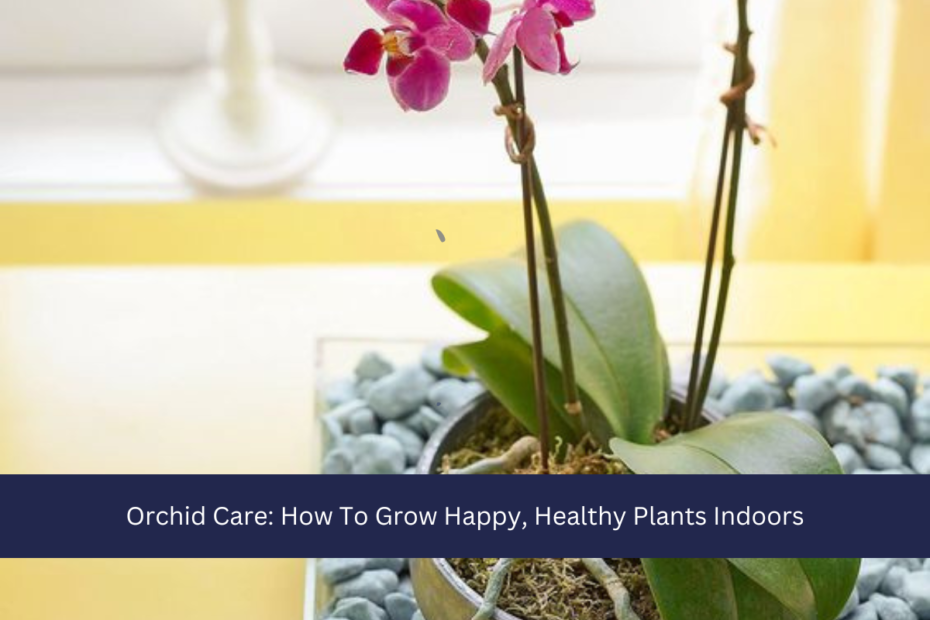Orchid Care: How To Grow Happy, Healthy Plants Indoors:It can be a rewarding and captivating experience to grow orchids indoors, adding a touch of elegance to your living area. Understanding orchids’ unique requirements and how to satisfy them inside is essential to growing happy, healthy plants.
1. Choosing the Right Orchid
First, choose the appropriate orchid variety for indoor cultivation. Beginners can benefit greatly from orchids like Phalaenopsis, sometimes known as moth orchids, because of their versatility and long-lasting blossoms.
They are a popular choice because they can flourish in regular indoor conditions. Cattleyas and dendrobiums are also great choices, but they might need a little more care and attention to detail.
2. Light
An essential component of orchid care is light. In general, bright, indirect light is ideal for orchid growth. The intense sun can scorch their fragile leaves, therefore they don’t do well there.
The ideal location is close to a window that filters light, such one that faces east or south, so they may get lots of strong light without the harshness of direct sunlight. In situations where natural light is scarce, particularly in the winter, you may need to use grow lights that replicate the spectrum of natural sunshine, such as fluorescent or LED grow lights.
3. Temperature
Another crucial component of caring for orchids indoors is controlling temperature. The majority of orchids like daytime temperatures between 65 and 75 degrees Fahrenheit. A temperature dip to between 55 and 65 degrees Fahrenheit at night can aid in the blooming process.
For the plant’s growth cycle, this small variation in temperature between day and night is frequently advantageous. Avoid putting orchids near heaters, air conditioners, or drafts from windows since sudden temperature fluctuations can cause stress to the plant.
4. Watering
Watering requires a careful balance. Because they dislike sitting in soggy soil, orchids require sufficient drainage. When the top inch or two of the potting mix feels dry to the touch, water your orchids. This usually entails watering once a week, though the frequency of watering may change based on the humidity and indoor conditions.
If at all feasible, use filtered room-temperature water; tap water with a high mineral concentration can cause issues over time. To avoid root rot, make sure that any extra water can escape the pot when you water it.
5. Humidity
The health of orchids is significantly influenced by humidity. Higher relative humidity is excellent for orchid growth, between 40 and 60 percent. A humidity tray or room humidifier can help maintain the proper moisture levels in many indoor spaces, especially in the winter when heating systems can dry out the air.
You can raise the surrounding humidity of your orchid by setting it on a humidity tray that is filled with water and rocks. Plants grouped together can also produce a more humid microclimate.
6. Potting Mix
Ordinary potting soil is not the same as the potting mix used for orchids. Generally speaking, orchids need a well-draining mixture that frequently includes charcoal, perlite, and bark. This combination mimics their natural growing circumstances on tree branches or in well-drained forest floors, allowing for great drainage and aeration.
Orchids typically require repotting every one to two years, or more frequently if the potting mix begins to degrade and become less effective. Repotting is most effective when the plant has finished flowering.
7. Fertilizing
In order to encourage healthy development and flowering, fertilization is essential. Use a fertilizer designed especially for orchids or one that is balanced for orchids. A 30-10-10 or 20-20-20 ratio is usually effective.
Fertilize every two to four weeks during the active growing season, which is often spring and summer. When the plant’s growth slows down in the fall and winter, reduce the frequency of fertilizing.
ALSO SEE:How To Keep Cosmos Blooming Strong – From Spring Until Fall!
8. Pruning and Maintenance
Maintaining and pruning your orchids will help them stay in peak shape. Remove spent flower spikes to promote fresh development after the blooming season. To avoid any illnesses, remove any yellowed or decaying leaves. Examine the roots frequently; strong, white or green roots indicate good health. Trim away any diseased or rotten roots you find, then repot the plant if needed.
9. Pests and Diseases
Finally, keep an eye out for illnesses and pests. Aphids, spider mites, and mealybugs are common pests of orchids. Neem oil or insecticidal soap can be used to treat them. Overwatering or inadequate air circulation are common causes of fungal infections and root rot. Assure adequate drainage and refrain from overhead watering to avoid these problems.
10. Encouraging Blooming
You may create an environment where your indoor orchids not only survive but thrive, rewarding you with their exquisite and exotic flowers, by comprehending and attending to these several aspects of orchid care.
